Severe Weather Preparedness
Thunderstorms and Lightning
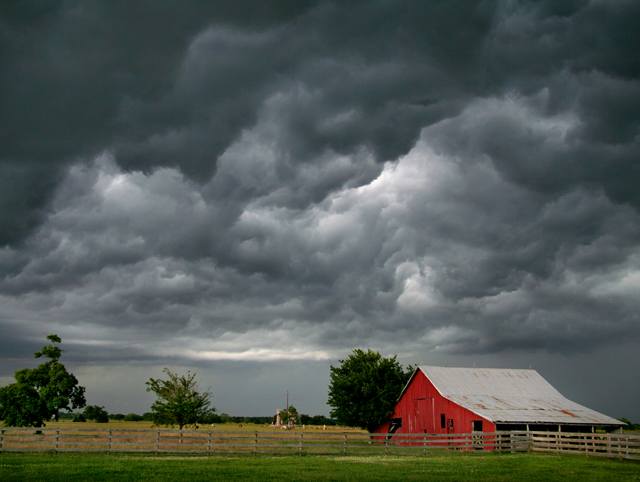
All thunderstorms are dangerous. Every thunderstorm produces lightning. In the United States, an average of 300 people are injured and 80 people are killed each year by lightning. Although most lightning victims survive, people struck by lightning often report a variety of long-term, debilitating symptoms.
Other associated dangers of thunderstorms include tornadoes, strong winds, hail, and flash flooding. Flash flooding is responsible for more fatalities—more than 140 annually—than any other thunderstorm-associated hazard.
Dry thunderstorms that do not produce rain that reaches the ground are most prevalent in the western United States. Falling raindrops evaporate, but lightning can still reach the ground and can start wildfires.
The following are facts about thunderstorms:
-
They may occur singly, in clusters, or in lines.
-
Some of the most severe occur when a single thunderstorm affects one location for an extended time.
-
Thunderstorms typically produce heavy rain for a brief period, anywhere from 3 0 minutes to an hour.
-
Warm, humid conditions are highly favorable for thunderstorm development.
-
About 10 percent of thunderstorms are classified as severe—one that produces hail at least three-quarters of an inch in diameter, has winds of 58 miles per hour or higher, or produces a tornado.
The following are facts about lightning:
-
Lightning’s unpredictability increases the risk to individuals and property.
-
Lightning often strikes outside of heavy rain and may occur as far as 10 miles away from any rainfall.
-
“Heat lightning” is actually lightning from a thunderstorm too far away for thunder to be heard. However, the storm may be moving in your direction!
-
Most lightning deaths and injuries occur when people are caught outdoors in the summer months during the afternoon and evening.
-
Your chances of being struck by lightning are estimated to be 1 in 600,000, but could be reduced even further by following safety precautions.
-
Lightning strike victims carry no electrical charge and should be attended to immediately.
Know the Terms
Familiarize yourself with these terms to help identify a thunderstorm hazard:
Severe Thunderstorm: WatchTells you when and where severe thunderstorms are likely to occur. Watch the sky and stay tuned to NOAA Weather Radio, commercial radio, or television for information.
Severe Thunderstorm Warning: Issued when severe weather has been reported by spotters or indicated by radar. Warnings indicate imminent danger to life and property to those in the path of the storm.
Take Protective Measures
Before Thunderstorms and Lightning
To prepare for a thunderstorm, you should do the following:
-
Remove dead or rotting trees and branches that could fall and cause injury or damage during a severe thunderstorm.
-
Remember the 30/30 lightning safety rule: Go indoors if, after seeing lightning, you cannot count to 30 before hearing thunder. Stay indoors for 30 minutes after hearing the last clap of thunder.
Thunderstorms
The following are guidelines for what you should do if a thunderstorm is likely in your area:
-
Postpone outdoor activities.
-
Get inside a home, building, or hard top automobile (not a convertible). Although you may be injured if lightning strikes your car, you are much safer inside a vehicle than outside.
-
Remember, rubber-soled shoes and rubber tires provide NO protection from lightning. However, the steel frame of a hard-topped vehicle provides increased protection if you are not touching metal.
-
Secure outdoor objects that could blow away or cause damage.
-
Shutter windows and secure outside doors. If shutters are not available, close window blinds, shades, or curtains.
-
Avoid showering or bathing. Plumbing and bathroom fixtures can conduct electricity.
-
Use a corded telephone only for emergencies. Cordless and cellular telephones are safe to use.
-
Unplug appliances and other electrical items such as computers and turn off air conditioners. Power surges from lightning can cause serious damage.
-
Use your battery-operated NOAA Weather Radio for updates from local officials.
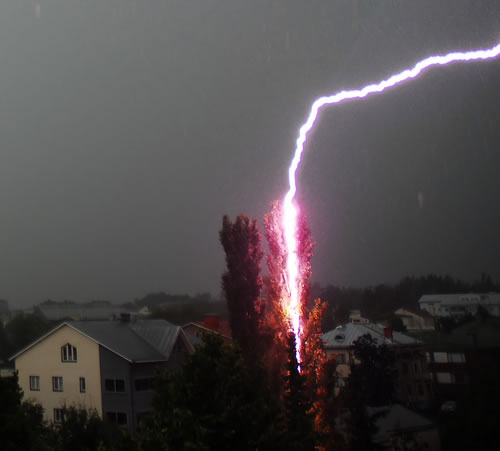
Lightning
Avoid the following:
-
Natural lightning rods such as a tall, isolated tree in an open area
-
Hilltops, open fields, the beach, or a boat on the water
-
Isolated sheds or other small structures in open areas
-
Anything metal—tractors, farm equipment, motorcycles, golf carts, golf clubs, and bicycles
Tornadoes
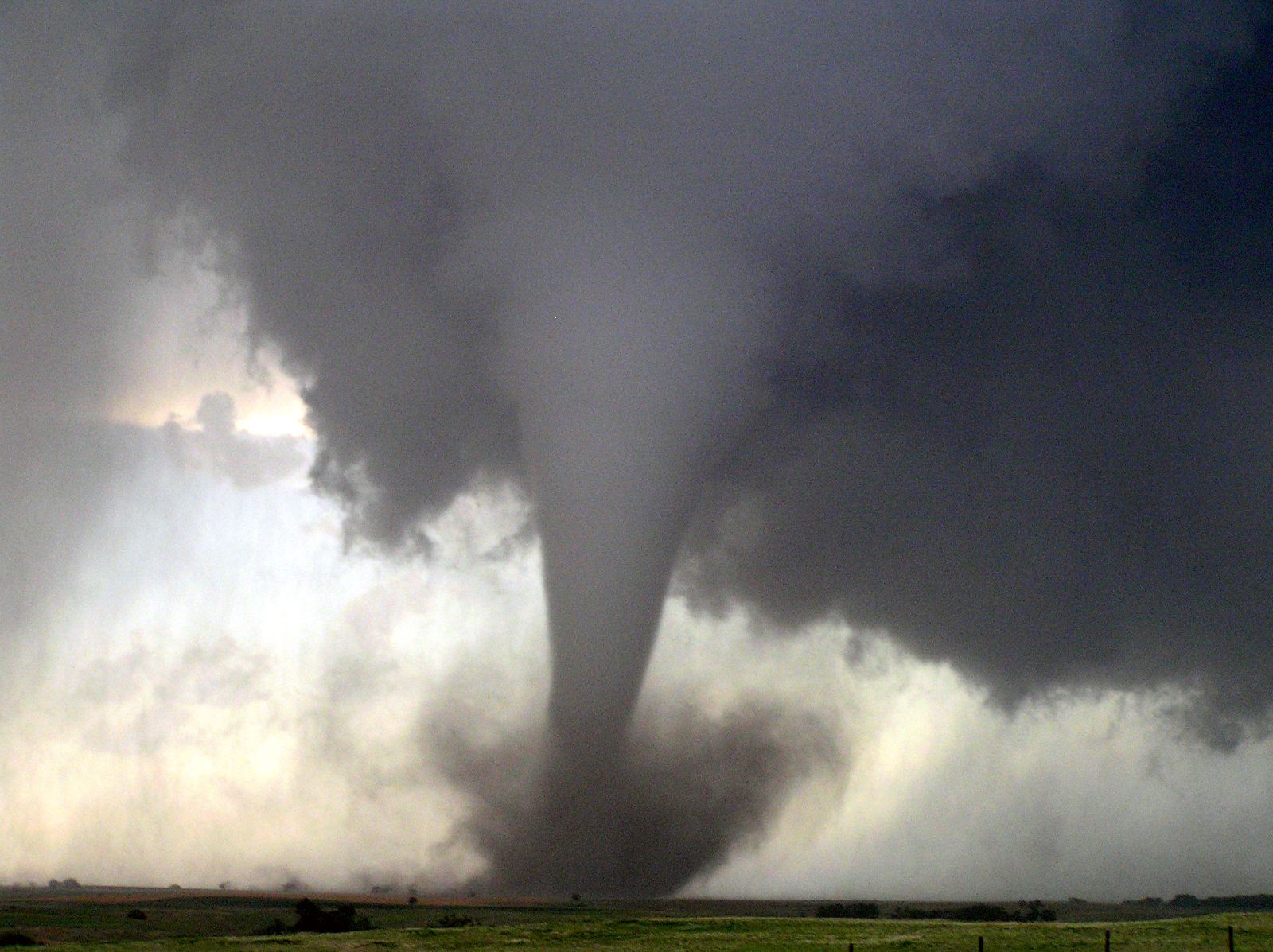
Tornadoes are nature’s most violent storms. Spawned from powerful thunderstorms, tornadoes can cause fatalities and devastate a neighborhood in seconds. A tornado appears as a rotating, funnel-shaped cloud that extends from a thunderstorm to the ground with whirling winds that can reach 300 miles per hour. Damage paths can be in excess of one mile wide and 50 miles long. Every state is at some risk from this hazard.
Some tornadoes are clearly visible, while rain or nearby low-hanging clouds obscure others. Occasionally, tornadoes develop so rapidly that little, if any, advance warning is possible.
Before a tornado hits, the wind may die down and the air may become very still. A cloud of debris can mark the location of a tornado even if a funnel is not visible. Tornadoes generally occur near the trailing edge of a thunderstorm. It is not uncommon to see clear, sunlit skies behind a tornado.
The following are facts about tornadoes:
-
They may strike quickly, with little or no warning.
-
They may appear nearly transparent until dust and debris are picked up or a cloud forms in the funnel.
-
The average tornado moves Southwest to Northeast, but tornadoes have been known to move in any direction.
-
The average forward speed of a tornado is 30 MPH, but may vary from stationary to 70 MPH.
-
Tornadoes can accompany tropical storms and hurricanes as they move onto land.
-
Waterspouts are tornadoes that form over water.
-
Tornadoes are most frequently reported east of the Rocky Mountains during spring and summer months.
-
Peak tornado season in the southern states is March through May; in the northern states, it is late spring through early summer.
-
Tornadoes are most likely to occur between 3 p.m. and 9 p.m., but can occur at any time.
Know the Terms
Familiarize yourself with these terms to help identify a tornado hazard:
Tornado Watch: Tornadoes are possible. Remain alert for approaching storms. Watch the sky and stay tuned to NOAA Weather Radio, commercial radio, or television for information.
Tornado Warning: A tornado has been sighted or indicated by weather radar. Take shelter immediately.
Take Protective Measures
Before a Tornado
-
Be alert to changing weather conditions.
-
Listen to NOAA Weather Radio or to commercial radio or television newscasts for the latest information.
-
Look for approaching storms.
Look for the following danger signs:
-
Dark, often greenish sky
-
Large hail
-
A large, dark, low-lying cloud (particularly if rotating)
-
Loud roar, similar to a freight train.
If you see approaching storms or any of the danger signs, be prepared to take shelter immediately.
During a Tornado
If you are under a tornado WARNING, seek shelter immediately!
If you are in:
A structure (e.g. residence, small building, school, nursing home, hospital, factory, shopping center, high-rise building): Go to a pre-designated shelter area such as a safe room, basement, storm cellar, or the lowest building level. If there is no basement, go to the center of an interior room on the lowest level (closet, interior hallway) away from corners, windows, doors, and outside walls. Put as many walls as possible between you and the outside. Get under a sturdy table and use your arms to protect your head and neck. Do not open windows.
A vehicle, trailer, or mobile home: Get out immediately and go to the lowest floor of a sturdy, nearby building or a storm shelter. Mobile homes, even if tied down, offer little protection from tornadoes.
The outside with no shelter: Lie flat in a nearby ditch or depression and cover your head with your hands. Be aware of the potential for flooding. Do not get under an overpass or bridge. You are safer in a low, flat location.
Preparing a Safe Room
Extreme windstorms in many parts of the country pose a serious threat to buildings and their occupants. Your residence may be built “to code,” but that does not mean it can withstand winds from extreme events such as tornadoes and major hurricanes. The purpose of a safe room or a wind shelter is to provide a space where you and your family can seek refuge that provides a high level of protection. You can build a safe room in one of several places in your home.
-
Your basement.
-
Atop a concrete slab-on-grade foundation or garage floor.
-
An interior room on the first floor.
-
Safe rooms built below ground level provide the greatest protection, but a safe room built in a first-floor interior room also can provide the necessary protection. Below-ground safe rooms must be designed to avoid accumulating water during the heavy rains that often accompany severe windstorms.
-
To protect its occupants, a safe room must be built to withstand high winds and flying debris, even if the rest of the residence is severely damaged or destroyed. Consider the following when building a safe room:
-
The safe room must be adequately anchored to resist overturning and uplift.
-
The walls, ceiling, and door of the shelter must withstand wind pressure and resist penetration by windborne objects and falling debris.
-
The connections between all parts of the safe room must be strong enough to resist the wind.
-
Sections of either interior or exterior residence walls that are used as walls of the safe room, must be separated from the structure of the residence so that damage to the residence will not cause damage to the safe room.
Floods
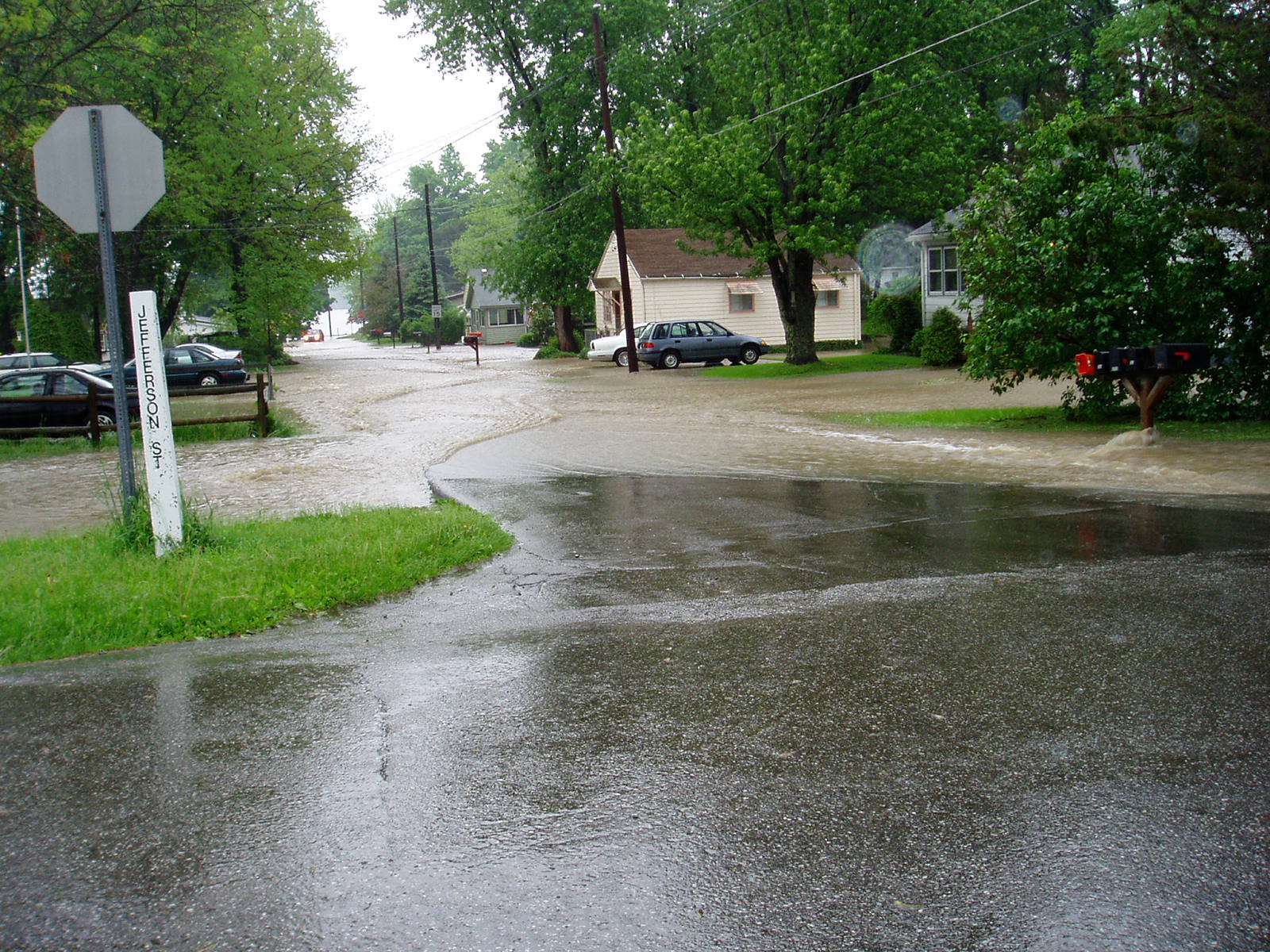
Floods are one of the most common hazards in the United States. Flood effects can be local, impacting a neighborhood or community, or very large, affecting entire river basins and multiple states.
However, all floods are not alike. Some floods develop slowly, sometimes over a period of days. But flash floods can develop quickly, sometimes in just a few minutes and without any visible signs of rain. Flash floods often have a dangerous wall of roaring water that carries rocks, mud, and other debris and can sweep away most things in its path. Overland flooding occurs outside a defined river or stream, such as when a levee is breached, but still can be destructive. Flooding can also occur when a dam breaks, producing effects similar to flash floods.
Be aware of flood hazards no matter where you live, but especially if you live in a low-lying area, near water or downstream from a dam. Even very small streams, gullies, creeks, culverts, dry streambeds, or low-lying ground that appear harmless in dry weather can flood. Every state is at risk from this hazard.
Know the Terms
Familiarize yourself with these terms to help identify a flood hazard:
Flood Watch: Flooding is possible. Tune in to NOAA Weather Radio, commercial radio, or television for information.
Flash Flood Watch: Flash flooding is possible. Be prepared to move to higher ground; listen to NOAA Weather Radio, commercial radio, or television for information.
Flood Warning: Flooding is occurring or will occur soon; if advised to evacuate, do so immediately.
Flash Flood Warning: A flash flood is occurring; seek higher ground on foot immediately.
Take Protectice Measures Before a Flood To prepare for a flood, you should:
-
Avoid building in a floodplain unless you elevate and reinforce your home.
-
Elevate the furnace, water heater, and electric panel if susceptible to flooding.
-
Install "check valves" in sewer traps to prevent flood water from backing up into the drains of your home.
-
Construct barriers (levees, beams, floodwalls) to stop floodwater from entering the building.
-
Seal walls in basements with waterproofing compounds to avoid seepage.
During a Flood, you should:
-
Listen to the radio or television for information.
-
Be aware that flash flooding can occur. If there is any possibility of a flash flood, move immediately to higher ground. Do not wait for instructions to move.
-
Be aware of streams, drainage channels, canyons, and other areas known to flood suddenly. Flash floods can occur in these areas with or without such typical warnings as rain clouds or heavy rain.
If you must prepare to evacuate, you should do the following:
-
Secure your home. If you have time, bring in outdoor furniture. Move essential items to an upper floor.
-
Turn off utilities at the main switches or valves if instructed to do so. Disconnect electrical appliances. Do not touch electrical equipment if you are wet or standing in water.
-
Do not walk through moving water. Six inches of moving water can make you fall. If you have to walk in water, walk where the water is not moving. Use a stick to check the firmness of the ground in front of you.
-
Do not drive into flooded areas. If floodwaters rise around your car, abandon the car and move to higher ground if you can do so safely. You and the vehicle can be quickly swept away.
Driving Flood Facts

The following are important points to remember when driving in flood conditions:
-
Six inches of water will reach the bottom of most passenger cars causing loss of control and possible stalling.
-
A foot of water will float many vehicles.
-
Two feet of rushing water can carry away most vehicles including sport utility vehicles (SUV’s) and pick-ups.
After a Flood
-
The following are guidelines for the period following a flood:
-
Listen for news reports to learn whether the community’s water supply is safe to drink.
-
Avoid floodwaters; water may be contaminated by oil, gasoline, or raw sewage. Water may also be electrically charged from underground or downed power lines.
-
Avoid moving water.
-
Be aware of areas where floodwaters have receded. Roads may have weakened and could collapse under the weight of a car.
-
Stay away from downed power lines, and report them to the power company.
-
Return home only when authorities indicate it is safe.
-
Stay out of any building if it is surrounded by floodwaters.
-
Use extreme caution when entering buildings; there may be hidden damage, particularly in foundations.
-
Service damaged septic tanks, cesspools, pits, and leaching systems as soon as possible. Damaged sewage systems are serious health hazards.
-
Clean and disinfect everything that got wet. Mud left from floodwater can contain sewage and chemicals.
Winter Storms and Extreme Cold
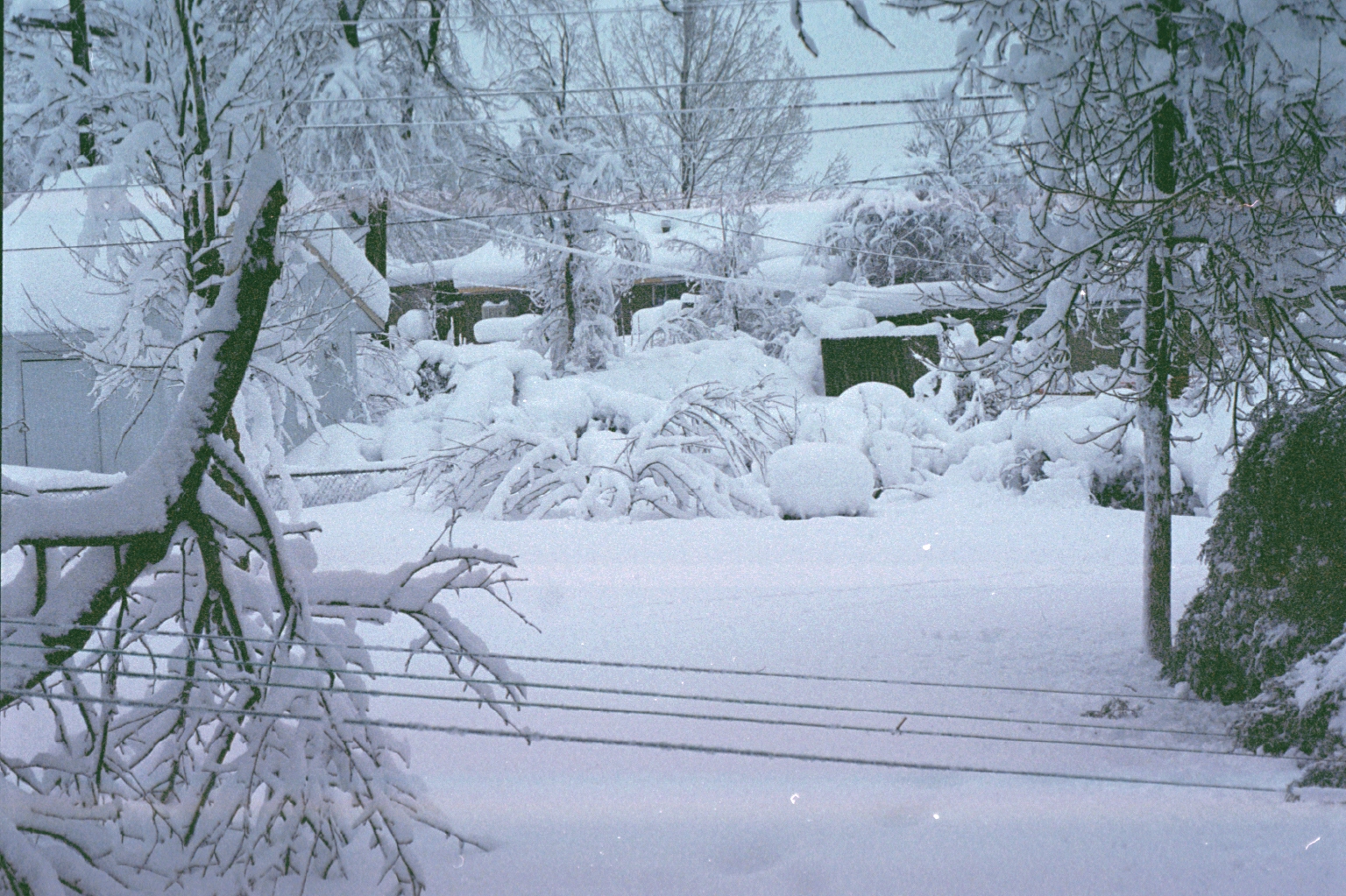
Heavy snowfall and extreme cold can immobilize an entire region. Even areas that normally experience mild winters can be hit with a major snowstorm or extreme cold. Winter storms can result in flooding, storm surge, closed highways, blocked roads, downed power lines and hypothermia.
Know the Terms
Familiarize yourself with these terms to help identify a winter storm hazard:
Freezing Rain: Rain that freezes when it hits the ground, creating a coating of ice on roads, walkways, trees, and power lines.
Sleet: Rain that turns to ice pellets before reaching the ground. Sleet also causes moisture on roads to freeze and become slippery.
Winter Storm Watch: A winter storm is possible in your area. Tune in to NOAA Weather Radio, commercial radio, or television for more information.
Winter Storm Warning: A winter storm is occurring or will soon occur in your area.
Blizzard Warning: Sustained winds or frequent gusts to 35 miles per hour or greater and considerable amounts of falling or blowing snow (reducing visibility to less than a quarter mile) are expected to prevail for a period of three hours or longer.
Frost/Freeze Warning: Below freezing temperatures are expected.
Take Protective Measures
Before Winter Storms and Extreme Cold
Include the following in your disaster supplies kit:
-
Rock salt to melt ice on walkways
-
Sand to improve traction
-
Snow shovels and other snow removal equipment.
-
Prepare for possible isolation in your home by having sufficient heating fuel; regular fuel sources may be cut off. For example, store a good supply of dry, seasoned wood for your fireplace or wood-burning stove.
-
Winterize your home to extend the life of your fuel supply by insulating walls and attics, caulking and weather-stripping doors and windows, and installing storm windows or covering windows with plastic.
To winterize your car, attend to the following:
-
Battery and ignition system should be in top condition and battery terminals clean.
-
Ensure antifreeze levels are sufficient to avoid freezing.
-
Ensure the heater and defroster work properly.
-
Check and repair windshield wiper equipment; ensure proper washer fluid level.
-
Ensure the thermostat works properly.
-
Check lights and flashing hazard lights for serviceability.
-
Check for leaks and crimped pipes in the exhaust system; repair or replace as necessary. Carbon monoxide is deadly and usually gives no warning.
-
Check breaks for wear and fluid levels.
-
Check oil for level and weight. Heavier oils congeal more at low temperatures and do not lubricate as well.
-
Consider snow tires, snow tires with studs, or chains.
-
Replace fuel and air filters. Keep water out of the system by using additives and maintaining a full tank of gas.
Dress for the Weather
-
Wear several layers of loose fitting, lightweight, warm clothing rather than one layer of heavy clothing. The outer garments should be tightly woven and water repellent.
-
Wear mittens, which are warmer than gloves.
-
Wear a hat.
-
Cover your mouth with a scarf to protect your lungs.
During a Winter Storm
The following are guidelines for what you should do during a winter storm or under conditions of extreme cold:
-
Listen to your radio, television, or NOAA Weather Radio for weather reports and emergency information.
-
Eat regularly and drink ample fluids, but avoid caffeine and alcohol.
-
Avoid overexertion when shoveling snow. Overexertion can bring on a heart attack—a major cause of death in the winter. If you must shovel snow, stretch before going outside.
-
Watch for signs of frostbite. These include loss of feeling and white or pale appearance in extremities such as fingers, toes, ear lobes, and the tip of the nose. If symptoms are detected, get medical help immediately.
-
Watch for signs of hypothermia. These include uncontrollable shivering, memory loss, disorientation, incoherence, slurred speech, drowsiness, and apparent exhaustion. If symptoms of hypothermia are detected, get the victim to a warm location, remove wet clothing, warm the center of the body first, and give warm, non-alcoholic beverages if the victim is conscious. Get medical help as soon as possible.
-
Conserve fuel, if necessary, by keeping your residence cooler than normal. Temporarily close off heat to some rooms.
-
Maintain ventilation when using kerosene heaters to avoid build-up of toxic fumes. Refuel kerosene heaters outside and keep them at least three feet from flammable objects.
-
Drive only if it is absolutely necessary. If you must drive, consider the following:
-
Travel in the day, don’t travel alone, and keep others informed of your schedule
-
Stay on main roads; avoid back road shortcuts
-
If a blizzard traps you in the car, keep these guidelines in mind:
-
Pull off the highway. Turn on hazard lights and hang a distress flag from the radio antenna or window.
-
Remain in your vehicle where rescuers are most likely to find you. Do not set out on foot unless you can see a building close by where you know you can take shelter. Be careful; distances are distorted by blowing snow. A building may seem close, but be too far to walk to in deep snow.
-
Run the engine and heater about 10 minutes each hour to keep warm. When the engine is running, open an upwind window slightly for ventilation. This will protect you from possible carbon monoxide poisoning. Periodically clear snow from the exhaust pipe.
-
Exercise to maintain body heat, but avoid overexertion. In extreme cold, use road maps, seat covers, and floor mats for insulation. Huddle with passengers and use your coat for a blanket.
-
Take turns sleeping. One person should be awake at all times to look for res-cue crews.
-
Drink fluids to avoid dehydration.
-
Be careful not to waste battery power. Balance electrical energy needs - the use of lights, heat, and radio - with supply.
-
Turn on the inside light at night so work crews or rescuers can see you.
-
If stranded in a remote area, stomp large block letters in an open area spelling out HELP or SOS and line with rocks or tree limbs to attract the attention of rescue personnel who may be surveying the area by airplane.
-
Leave the car and proceed on foot - if necessary - once the blizzard passes.
Assemble a Disaster Supplies Kit
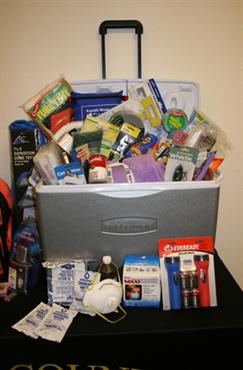
You may need to survive on your own after a disaster. This means having your own food, water, and other supplies in sufficient quantity to last for at least three days. Local officials and relief workers will be on the scene after a disaster, but they cannot reach everyone immediately. You could get help in hours, or it might take days.
Basic services such as electricity, gas, water, sewage treatment, and telephones may be cut off for days, or even a week or longer. Or, you may have to evacuate at a moment’s notice and take essentials with you. You probably will not have the opportunity to shop or search for the supplies you need.
A disaster supplies kit is a collection of basic items that members of a household may need in the event of a disaster.
Kit Locations
Since you do not know where you will be when an emergency occurs, prepare supplies for home, work, and vehicles.
Home: Your disaster supplies kit should contain essential food, water, and supplies for at least three days. Keep this kit in a designated place and have it ready in case you have to leave your home quickly. Make sure all family members know where the kit is kept. Additionally, you may want to consider having supplies for sheltering for up to two weeks.
Car: This kit should contain food, water, first aid supplies, flares, jumper cables, and seasonal supplies.
Water
How Much Water do I Need?
You should store at least one gallon of water per person per day. A normally active person needs at least one-half gallon of water daily just for drinking.
Additionally, in determining adequate quantities, take the following into account:
-
Individual needs vary, depending on age, physical condition, activity, diet, and climate.
-
Children, nursing mothers, and ill people need more water.
-
Very hot temperatures can double the amount of water needed.
-
A medical emergency might require additional water.
How Should I Store Water?
To prepare safest and most reliable emergency supply of water, it is recommended you purchase commercially bottled water. Keep bottled water in its original container and do not open it until you need to use it.
Observe the expiration or “use by” date.
If you are preparing your own containers of water, it is recommended you purchase food-grade water storage containers from surplus or camping supplies stores to use for water storage. Before filling with water, thoroughly clean the containers with dishwashing soap and water, and rinse completely so there is no residual soap. Follow directions below on filling the container with water.
If you choose to use your own storage containers, choose two-liter plastic soft drink bottles – not plastic jugs or cardboard containers that have had milk or fruit juice in them. Milk protein and fruit sugars cannot be adequately removed from these containers and provide an environment for bacterial growth when water is stored in them. Cardboard containers also leak easily and are not designed for long-term storage of liquids. Also, do not use glass containers, because they can break and are heavy.
If storing water in plastic soda bottles, follow these steps
-
Thoroughly clean the bottles with dishwashing soap and water, and rinse completely so there is no residual soap.Sanitize the bottles by adding a solution of 1 teaspoon of non-scented liquid household chlorine bleach to a quart of water. Swish the sanitizing solution in the bottle so that it touches all surfaces. After sanitizing the bottle, thoroughly rinse out the sanitizing solution with clean water.
Filling water containers
Fill the bottle to the top with regular tap water. If the tap water has been commercially treated from a water utility with chlorine, you do not need to add anything else to the water to keep it clean. If the water you are using comes from a well or water source that is not treated with chlorine, add two drops of non-scented liquid household chlorine bleach to the water.Tightly close the container using the original cap. Be careful not to contaminate the cap by touching the inside of it with your finger. Place a date on the outside of the container so that you know when you filled it. Store in a cool, dark place.Replace the water every six months if not using commercially bottled water.
Food
The following are things to consider when putting together your food supplies:
-
Avoid foods that will make you thirsty. Choose salt-free crackers, whole grain cereals, and canned foods with high liquid content.
-
Stock canned foods, dry mixes, and other staples that do not require refrigeration, cooking, water, or special preparation. You may already have many of these on hand. (Note: Be sure to include a manual can opener.)
-
Include special dietary needs.
Basic Disaster Supplies Kit
The following items are recommended for inclusion in your basic disaster supplies kit:
-
Three-day supply of non-perishable food.
-
Three-day supply of water - one gallon of water per person, per day.
-
Portable, battery-powered radio or television and extra batteries.
-
Flashlight and extra batteries.
-
First aid kit and manual.
-
Sanitation and hygiene items (moist towelettes and toilet paper).
-
Matches and waterproof container.
-
Whistle.
-
Extra clothing.
-
Kitchen accessories and cooking utensils, including a can opener.
-
Photocopies of credit and identification cards.
-
Cash and coins.
-
Special needs items, such as prescription medications, eye glasses, contact lens solutions, and hearing aid batteries.
-
Items for infants, such as formula, diapers, bottles, and pacifiers.
-
Other items to meet your unique family needs.
If you live in a cold climate, you must think about warmth. It is possible that you will not have heat. Think about your clothing and bedding supplies. Be sure to include one complete change of clothing and shoes per person, including:
-
Jacket or coat.
-
Long pants.
-
Long sleeve shirt.
-
Sturdy shoes.
-
Hat, mittens, and scarf.
-
Sleeping bag or warm blanket (per person).
Maintaining Your Disaster Supplies Kit
Just as important as putting your supplies together is maintaining them so they are safe to use when needed. Here are some tips to keep your supplies ready and in good condition:
-
Keep canned foods in a dry place where the temperature is cool.
-
Store boxed food in tightly closed plastic or metal containers to protect from pests and to extend its shelf life.
-
Throw out any canned good that becomes swollen, dented, or corroded.
-
Use foods before they go bad, and replace them with fresh supplies.
-
Place new items at the back of the storage area and older ones in the front.
-
Change stored food and water supplies every six months. Be sure to write the date you store it on all containers.
-
Re-think your needs every year and update your kit as your family needs change.
-
Keep items in airtight plastic bags and put your entire disaster supplies kit in one or two easy-to-carry containers, such as an unused trashcan, camping backpack, or duffel bag.
|

